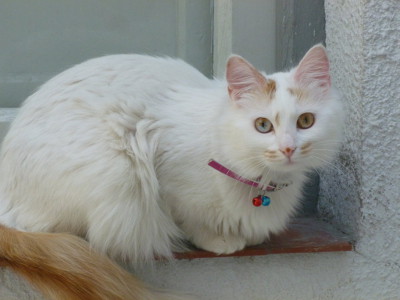Turkish Van Cat
Category: Cats

Facts about Turkish Van Cats. "Scientific name for Turkish Van Cat is Felis Catus". The Turkish Van Cat is a swimming cat that has a propensity to play in water. The Turkish Van Cats are an ancient breed which were considered to have originated from the Lake Van areas of Turkey. The cold climate, mountains and the rugged landscape is believed to have contributed to the masculine body and the cashmere-like coated fur of the Turkish Van Cats. The Turkish Van Cats are considered to be natural breeds which have existed for several years. At maturity, the Turkish Van Cat can weigh up to approximately 10 to 18 pounds(4.5 to 8 kg).
The average Turkish Van Cat temperature of a cat is 101.5 °F (38.6 cel). The Turkish Van Cats heart beats at 110 to 140 a minute, That is almost twice as fast as a human heart. A Turkish Van Cat can climb up a tree well but can not climb head first down a tree, because all the claws on a cat’s paw points the same direction, to get down from a tree, a Turkish Van Cat has to back down. A Turkish Van Cat can run at a top speed of about 30 mph (48.2 km) over a short distance. A Turkish Van Cat rubs against a person to not only to be affectionate but also to mark out its territory. A Turkish Van Cat averages about 12 whiskers on both side of its face. A Turkish Van Cats jaw can not move sideways, there for a cat can not chew large pieces of food. A Turkish Van Cats back is highly flexible because of its 53 loosely fitting vertebrae. The body of a cat has 230 bones. While a human body has 206. Compared to a humans who only have 34. The Turkish Van Cats have round muzzles, wedge-shaped head which is broad, medium-sized ears which have rounded tips and medium sized eyes which can either be amber, blue or one of the colors. The Turkish Van Cats have broad shoulders and chests with masculine and long legs and a powerful and strong body. The female Turkish Van Cat breeds are usually less masculine than their male counterparts.
The Turkish Van Cats are colored cats which have huge white patches on their semi-long single coated fur. These coloring are caused by a white spotting gene known as "piebald" (displaying irregular patches of two colors, typically white and black). The Turkish Van Cat can also have random colors on their head, body, tail and legs. The coloring in these types of breeds is known as the Van pattern and the colors can either be, black, cream, brown, blue, red, or tabby in red with their nose leather and paw pads being pink in color and sometimes with color spots.
Turkish Van Cats on average sleep 13 to 14 hours a day and when they are awake, the spend a lot of time licking themselves to keep themselves clean. The Turkish Van Cat are also considered to be affectionate and social. The Turkish Van Cat bond freely with members of their family. However, the Turkish Van Cat tend to choose their favorite person from the family. The Turkish Van Cat are athletic, highly active and can remain so playful even after maturity. The Turkish Van Cat are intelligent and can learn new games and tricks. The Turkish Van Cat loves playing with toys especially teaser toys which enables them to imitate pouncing on objects or prey.
Due to their single coated fur, the Turkish Van Cats are easier to take care of. The Turkish Van Cat require weekly grooming with the help of a slicker brush. This brush can help so it doesn't harm their single silky-textured coats. The Turkish Van Cat don’t require regular bathing as their coats are water-proof.
Cat Facts
There are over 500 million domestic cats in the world and 88 million in the United States Approximately 40,000 people are bitten by cats in the U.S. annually. Turkish Van Cats help control rodents like small rats and mice where the live homes, warehouse, ect. A female cat is called a "queen or molly", male cat is called a "tom" and the name "clowder" is called a group and young or baby cats are called kittens. Turkish Van Cats have very sharp hearing and their sense of smell is fantastic. Turkish Van Cats average life span is around 12 to 15 years. The reason why Turkish Van Cats can squeeze through very small spaces is that they have no collarbone and free-floating clavicle bones that their shoulders are attach to their forelimbs, that's why a Turkish Van Cat can fit through a hole the same size as its head and they use their whiskers to determine if they can fit through the space.
Turkish Van Cats can see at levels of light six time lower than a human, this is why cats can catch mice so easily at night. Turkish Van Cats outer ear uses 32 muscles to control it, and a human has only 6 muscles in its ear and a cat can move its ears 180 degrees. A Turkish Van Cat can move their ears independently. The cat's hairball is called a "bezoar" (meaning a concretion or calculus found in the intestines or stomach of certain animals, in particular ruminants, formerly alleged to be an effective cure for poison). A Turkish Van Cats has 30 teeth while a kittens has about 26 teeth that they will lose at about 6 months of age. A Turkish Van Cat has the ability to jump up to six times its length.

 Back To Category Cats
Back To Category Cats